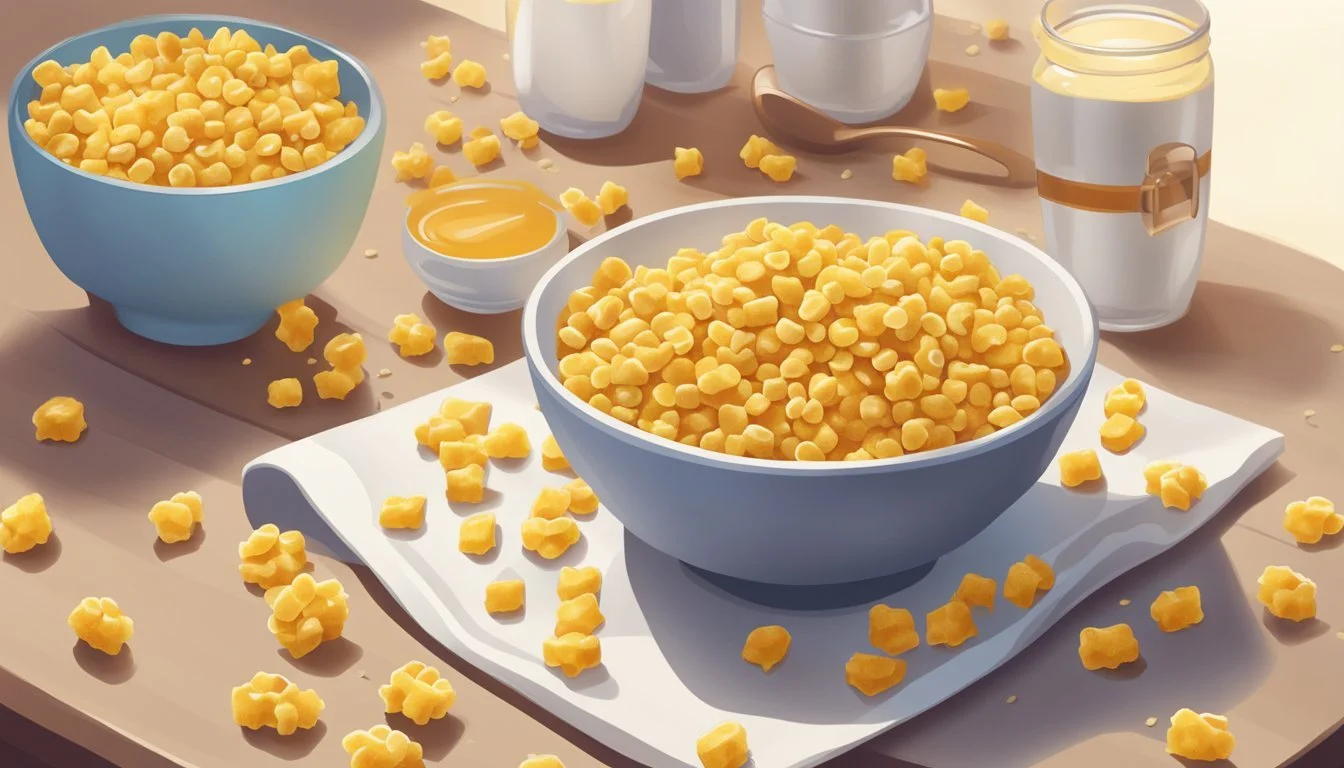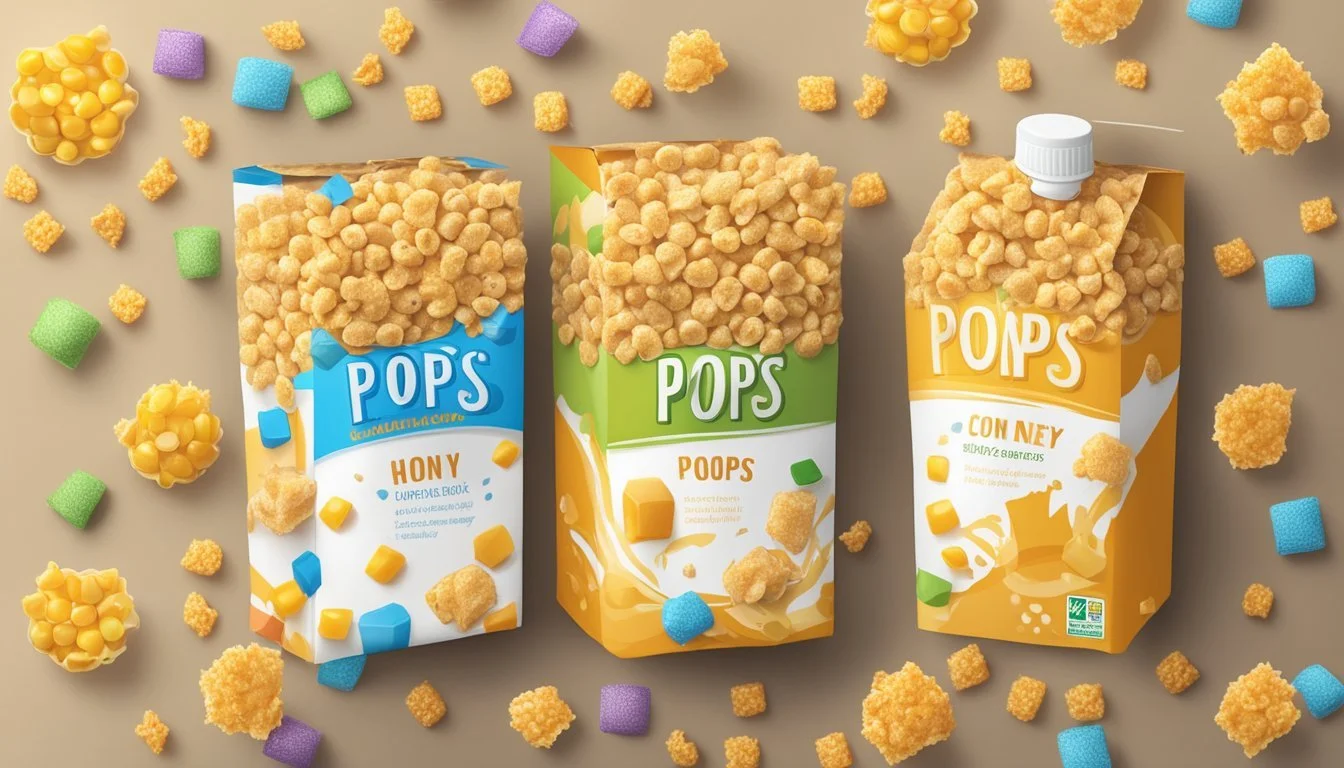Corn Pops vs Honey Ohs!
A Detailed Breakfast Cereal Comparison
This Article is Part of Our Breakfast Cereal Guide with Details on Corn Pops Nutrition and Honey Ohs! Nutrition
Choosing the right breakfast cereal can be a challenging decision with the plethora of options available. Two popular contenders in the cereal aisle are Corn Pops and Honey Ohs! When comparing the two, Corn Pops contain 13 grams of complex carbohydrates per serving, while Honey Ohs! have 12 grams. This offers a slight nutritional edge to Corn Pops for those monitoring their carb intake.
On the flavor front, Honey Ohs! are known for their sweet, syrupy honey glaze, adding a distinctive taste that many find appealing. Corn Pops, with their well-balanced sweetness, provide a classic and satisfying cereal experience without the heavier honey flavor. Both cereals offer a delightful crunch, making them popular choices for varied tastes.
For those seeking a nutritious breakfast, it is essential to consider more than just taste and carbs. Evaluating sugar content, fiber, and other nutritional elements can provide a more comprehensive view of each cereal's health benefits. This blog will delve into each cereal’s specifics to help you make an informed decision on your next cereal purchase.
History and Manufacturers
Corn Pops and Honey Ohs! each have distinct origins and evolving histories in the breakfast cereal market. This section covers the beginnings and transformations of these cereals, as well as the major companies behind them.
Origins of Corn Pops
Kellogg's Corn Pops Cereal was introduced to consumers in 1950. Initially named "Corn Pops," the cereal went through a couple of rebranding efforts—first to "Sugar Corn Pops" in 1951, and then to "Sugar Pops."
Kellogg's aimed to create a sweetened, puffed corn cereal that would appeal to children and parents alike. The marketing strategy included sponsorship of "The Adventures of Wild Bill Hickok" radio and television show. This affiliation helped boost its popularity among young audiences.
Evolution of Honey Ohs!
Honey Ohs!, initially launched as Oh’s! by the Quaker Oats Company in 1980, started with two flavors: "Crunchy Graham" and "Honey Nut." Over time, these varieties were consolidated under the "Honey Ohs!" brand in 1988.
Quaker Oats pitched Honey Ohs! as a hearty and flavorful option in the breakfast cereal aisle. In the following years, Post acquired the product, further leveraging its market presence. This acquisition did not alter the fundamental recipe but provided broader distribution channels.
Key Players in the Market
Kellogg's: The manufacturer of Corn Pops, Kellogg's has been a dominant player in the cereal market for decades. They are known for their robust marketing strategies and consistent product updates.
Quaker Oats: Initially introduced Honey Ohs! and brought innovation to breakfast cereals with its unique flavors. Quaker Oats is renowned for focusing on wholesome ingredients.
Post: After acquiring Honey Ohs!, Post maintained the quality while expanding its market reach. Post has a reputation for acquiring and nurturing well-loved cereal brands.
Both Kellogg's and Post have used marketing and quality to maintain consumer interest, making Corn Pops and Honey Ohs! enduring staples in many households.
Nutritional Analysis
Both Corn Pops and Honey Ohs! display distinct nutritional profiles, which are essential to consider when selecting a healthier breakfast option.
Macronutrients and Calories
Corn Pops offers 110 calories per serving, with 0 grams of fat. This cereal includes 25 grams of carbohydrates, 2 grams of dietary fiber, and 12 grams of sugar. It also contains 1 gram of protein per serving.
Honey Ohs! contains 170 calories per serving, with 3 grams of fat. This includes 2 grams of saturated fat. Honey Ohs! provides 33 grams of carbohydrates, 2 grams of dietary fiber, and 17 grams of sugar. Protein content stands at 2 grams per serving.
Vitamins and Minerals Content
Corn Pops and Honey Ohs! differ in their vitamins and minerals content. Corn Pops contains 90 milligrams of sodium, but provides a significant amount of iron, at 6 milligrams. However, it lacks higher amounts of essential vitamins such as vitamins A and C.
Honey Ohs! includes 220 milligrams of sodium. It provides 75% of the daily need coverage for Manganese. Additionally, it contains 29.1 micrograms of Selenium and falls short on other vitamins and minerals compared to more fortified cereals.
Ingredients Breakdown
When analyzing ingredients, Corn Pops uses a base of milled corn, sugar, and multiple food additives. These additives may include high fructose corn syrup and hydrogenated oils, raising concerns for those looking for a cleaner ingredient list.
Honey Ohs! ingredients include a combination of whole grain oat flour and sugar along with honey and other flavoring agents. While it also includes additives, the presence of whole grains may offer additional nutritional benefits over Corn Pops' processed components.
Summarizing these elements is crucial for understanding what each cereal offers nutritionally.
Taste Profile and Consumer Perception
Analyzing both Corn Pops and Honey Ohs reveals distinct differences in flavor, texture, and consumer sentiment. These cereals offer unique taste experiences shaped by specific ingredients and preparation methods.
Flavor Comparison
Corn Pops has a characteristically sweet, slightly buttery flavor, thanks to its combination of corn grits and sugar. This cereal's sweetness is straightforward and appeals primarily to those who enjoy uncomplicated flavors.
In contrast, Honey Ohs provides a richer taste experience. The honey-coated oats deliver a complex, syrupy sweetness with a hint of golden honey flavor. The absence of graham in the current formulation makes it different from its earlier versions but does not detract from its honey-forward profile.
Texture and Crunch Factor
Corn Pops are known for their light, airy texture, which stays relatively crisp even after adding milk. The puffs soften gradually, providing a pleasant mouthfeel throughout the eating experience.
Honey Ohs, on the other hand, offer a substantial crunch due to their dense honeycomb shape. They maintain their sturdiness in milk longer than Corn Pops, delivering a consistent crunch until the end. Their smoother texture ensures they do not scratch the mouth, making them enjoyable for a wider range of consumers.
Consumer Reviews and Preferences
Consumer reviews indicate a clear preference split based on flavor and texture. Fans of Corn Pops appreciate its sweet simplicity and welcoming crunch that turns softer in milk. Many consumers grew up with this cereal, adding a nostalgic value.
Honey Ohs' loyalists commend the robust honey flavor and the cereal's ability to retain crunchiness. Although changes in formulation (like the removal of graham) have been noted, the core elements of flavor and texture keep it a favorite. Reviews often highlight the honey glaze's richness and the satisfying crunch that lasts in milk.
These preferences underline the importance of flavor and texture in shaping consumer choices for breakfast cereals. Corn Pops and Honey Ohs carve distinct niches, appealing to varied tastes and textural preferences.
Dietary Considerations
Choosing between Corn Pops and Honey Ohs! involves evaluating their suitability for various dietary preferences such as low fat, low carb, low calorie, and low glycemic index diets. Detailed information about each aspect is provided below.
For a Low Fat Diet
Corn Pops contain 0 grams of saturated fat, while Honey Ohs! have 3 grams of total fat per serving, but no saturated fat. According to the FDA, a low-fat diet should limit total fat intake to less than 30% of total daily calories. Both cereals fall within these guidelines, with Corn Pops being a slightly better choice due to lower overall fat content.
Serving for Low Carb Diet
Carbohydrates are a significant part of both cereals. Corn Pops contain 26 grams of total carbs per serving, and Honey Ohs! have 36 grams per serving. To follow a low-carb diet, limiting net carbs is essential. Corn Pops may be preferable for those adhering strictly to low carb limits, as they have fewer carbs than Honey Ohs!.
Suitability for Low Calorie Diet
Each serving of Corn Pops provides 150 calories, whereas Honey Ohs! have 170 calories per serving. For individuals aiming for a low-calorie diet, this difference might be minor but significant over time. Choosing Corn Pops could slightly reduce daily calorie intake while still providing a satisfying cereal option.
Low Glycemic Index Options
Neither Corn Pops nor Honey Ohs! explicitly state their glycemic index (GI) values. However, cereals with higher sugar content typically have a higher GI due to rapid digestion and blood sugar spikes. With 12 grams of sugar in Corn Pops and 11 grams in Honey Ohs!, both have relatively high sugar contents. Those on a low GI diet should consume these cereals in moderation or opt for whole grain alternatives known for lower GI values.
Serving Recommendations and Variations
Understanding how to best serve Corn Pops and Honey Ohs can enhance the cereal-eating experience. This section will explore ideal serving sizes, popular combinations with milk and toppings, and interesting alternative ways to enjoy these cereals.
Ideal Serving Size
A standard serving size for both Corn Pops and Honey Ohs is 1 cup. This portion provides a balanced intake while keeping calorie consumption in check.
Corn Pops typically weighs around 1.1 ounces per serving. Honey Ohs, being slightly denser, might weigh more per cup. Paying attention to serving sizes is crucial for maintaining nutritional balance. Consuming appropriate portions ensures that you get the intended nutritional benefits without excessive calories or sugar intake.
Popular Combinations with Milk and Toppings
Both Corn Pops and Honey Ohs pair excellently with different types of milk. Common choices include whole milk, skim milk, almond milk, and soy milk. Each type of milk can affect the cereal's flavor and texture.
For added flavor and nutrition, consider topping these cereals with fresh fruits like bananas, strawberries, or blueberries. Nuts such as almonds, walnuts, or pecans provide a delightful crunch and add healthy fats. Honey or maple syrup can also be drizzled over the cereal for an extra touch of sweetness.
Alternative Ways to Enjoy
Corn Pops and Honey Ohs aren't just limited to traditional bowl-and-milk servings. They can be used creatively in various recipes.
For a quick snack, mix them with other dry cereals and nuts to create a tasty trail mix. You can also incorporate them into dessert recipes like cereal bars or cookies. Another option is to use them as a topping for yogurt or ice cream, adding texture and flavor to your dessert.
Experimenting with these variations can make your cereal consumption more versatile and enjoyable.
Market Presence and Availability
Corn Pops and Honey Ohs! cereals have distinct distribution channels and price points. Their availability varies by region and online presence, making it crucial to understand where and how consumers can purchase these cereals.
Distribution and Retail Landscape
Corn Pops, manufactured by Kellogg's, enjoys widespread distribution across major grocery chains, such as Walmart, Target, and Safeway.
Honey Ohs!, made by Quaker Oats, is commonly found in similar retail outlets but may also be seen in specialty and regional grocery stores.
Both cereals benefit from the strong presence of their parent companies, ensuring a consistent supply.
Pricing and Value for Money
Corn Pops generally retail in the range of $3.50 to $5.00 per box, depending on the store and promotional discounts.
Honey Ohs! is priced similarly, often between $3.00 and $4.50.
When considering value for money, consumers typically look at the nutritional content, serving size, and taste satisfaction. Both offers good value, balancing price and quality.
Online Retail Opportunities
Both cereals are readily available in online marketplaces like Amazon, Walmart.com, and their respective brand websites.
Consumers can take advantage of bulk buying options and subscription services online, providing greater convenience and often better pricing.
Online retail provides access to customer reviews and ratings, assisting consumers in making informed purchasing decisions.
Environmental and Ethical Considerations
When comparing Corn Pops and Honey Ohs, it's essential to consider the environmental impact and ethical sourcing of ingredients. Sustainable practices and ethical sourcing play vital roles in ensuring the products are environmentally friendly and ethically produced.
Sustainable Production Practices
Corn Pops and Honey Ohs, like many cereals, rely heavily on agricultural products. Sustainable farming reduces the negative impact on the environment. Corn Pops, produced by Kellogg's, focuses on sustainability by improving soil health, water use efficiency, and reducing greenhouse gas emissions.
Honey Ohs by Quaker Oats incorporates sustainable grain farming. This involves crop rotation, reduced pesticide use, and water conservation practices. Sustainable beekeeping practices are also critical, especially for products containing honey. Ethical beekeepers prioritize the health of bee colonies and ecosystem balance.
Ethical Sourcing of Ingredients
Ensuring ethical sourcing of ingredients is fundamental in evaluating the environmental and social impacts of Corn Pops and Honey Ohs. For Corn Pops, sourcing non-GMO corn and supporting local farmers can enhance ethical standards.
Honey Ohs present unique challenges with honey. Ethical beekeeping emphasizes natural food sources and minimal intervention. This means healthier bees and more sustainable honey production. Choosing honey from Fairtrade producers also supports ethical practices, ensuring fair wages and sustainable farming for beekeepers.






